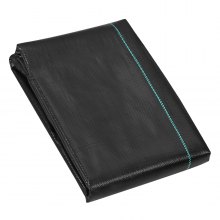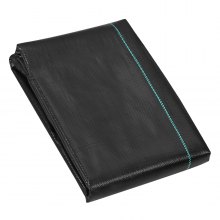







































Discover the unparalleled blend of durability and affordability with VEVOR's non-woven geotextile fabric, a must-have for any construction or landscaping project. Engineered with top-quality materials, this fabric stands out in the market for its exceptional strength and reliability, ensuring long-lasting performance in any application. Ideal for soil filtration, separation, protection, and drainage, VEVOR’s geotextile fabric is designed to meet the most demanding requirements of civil engineering, landscaping, and construction projects. Its unique non-woven structure promotes water flow while effectively preventing soil erosion, making it an indispensable solution for maintaining the integrity of your project. Affordably priced without compromising on quality, VEVOR’s geotextile fabric is the smart choice for professionals and DIY enthusiasts alike. Take the step towards ensuring the success of your project. Choose VEVOR’s non-woven geotextile fabric today and experience the perfect balance of performance and value. Don't wait, secure your foundation with confidence and pave the way for a successful project outcome.
The world of construction and landscaping is continuously evolving, with sustainable and efficient materials leading the way. Among these innovative materials is the non-woven geotextile fabric, a marvel of modern engineering designed to add durability and sustainability to your projects.
Non-woven geotextile fabric, a product born from high-tech processes, stands out for its unique properties and versatile applications. This fabric is crafted from synthetic fibers, merged through chemical, heat, or mechanical methods, resulting in a stable and consistent material ideal for various uses.
Sustainability is not just a buzzword; it's a necessary ethos. Non-woven geotextile fabrics contribute positively to environmental protection by enhancing soil stability and promoting effective water drainage, thus reducing erosion and pollution.
From roadway construction to erosion control, non-woven geotextile fabric finds its place. Its versatility makes it indispensable in civil engineering projects, landscaping, and agricultural practices, proving its worth across multiple domains.
Even the best materials fail without proper installation. Understanding the correct methods to lay down non-woven geotextile fabric is crucial for maximizing its benefits and ensuring long-term effectiveness in your projects.
Durability is a non-negotiable in construction materials. Non-woven geotextile fabric is celebrated for its resistance to punctures, tears, and biological degradation, ensuring that it remains a steadfast component of your project for years to come.
In the modern economic landscape, cost-effectiveness is king. Non-woven geotextile fabric offers an economical solution without compromising quality, providing significant financial benefits over traditional materials.
Erosion control is a major concern in environmental management. Non-woven geotextile fabric emerges as a champion in this arena, effectively mitigating soil erosion and promoting the stability of landscapes and infrastructures.
Proper drainage is the backbone of effective construction and landscaping. Non-woven geotextile fabric plays a pivotal role in facilitating efficient water flow and distribution, preventing waterlogging and associated problems.
In the realm of reinforcement, non-woven geotextile fabric shines. It reinforces soil and structures, enhancing their strength and stability under various conditions and loads.
Landscaping is not just about aesthetics; it's also about protection and sustainability. Non-woven geotextile fabric serves as an excellent underlayment that supports plant life while combating erosion and weed growth.
Agriculture benefits significantly from the use of non-woven geotextile fabric. It aids in soil moisture retention, weed control, and root protection, thereby supporting sustainable farming practices.
In the construction of roads and pathways, non-woven geotextile fabric is revolutionary. It stabilizes the ground, distributes loads evenly, and increases the lifespan of the pavement.
Beneath the surface, non-woven geotextile fabric works tirelessly to protect buried utilities and infrastructure from environmental stresses, ensuring their longevity and functionality.
Not all geotextiles are created equal. Selecting the right type of non-woven geotextile fabric for your specific project is crucial for achieving the desired outcomes and ensuring cost-efficiency.
Like any other material, non-woven geotextile fabric requires proper maintenance. Understanding the do's and don'ts of fabric care can significantly extend its lifespan and effectiveness.
Non-woven geotextile fabric often works best in tandem with other materials. Exploring innovative combinations can enhance the performance and durability of your projects.
The ecological footprint of construction materials is a growing concern. Delve into the environmental impact of non-woven geotextile fabric and understand how it aligns with green building practices.
The future is bright for non-woven geotextile fabric. With ongoing research and technological advancements, its applications and capabilities continue to expand, paving the way for new possibilities.
In the world of materials science, misunderstandings are common. It's crucial to dispel prevalent misconceptions about non-woven geotextile fabric to ensure its appropriate and effective use in various projects.
Understanding the regulatory landscape is essential for compliance and excellence. Familiarize yourself with the standards and regulations governing the use of non-woven geotextile fabric to ensure your projects meet all necessary guidelines.
While basic installation is straightforward, mastering advanced techniques can significantly enhance the performance and longevity of non-woven geotextile fabric in your projects. Explore detailed methods and best practices for optimal results.
Real-world examples provide valuable insights. Explore case studies highlighting the successful application of non-woven geotextile fabric in various sectors, offering practical lessons and inspiration.
Even with the best planning, challenges can arise. Equip yourself with troubleshooting tips and strategies to address common issues encountered when working with non-woven geotextile fabric.
When it comes to non-woven geotextile fabric, VEVOR stands out as a leading provider. Discover the advantages of partnering with VEVOR for your geotextile needs, from quality products to expert advice.
The journey of innovation never stops. Delve into the latest developments and future trends in non-woven geotextile fabric technology and how they can revolutionize your projects.
Successful projects require more than just quality materials. Embrace a holistic approach to project management, integrating non-woven geotextile fabric into a comprehensive plan for sustainable and efficient outcomes.
With an array of options, selecting the right non-woven geotextile fabric can be daunting. Learn how to choose the perfect product for your needs with VEVOR, ensuring a balance between performance, cost, and environmental impact.
Gain inspiration from VEVOR customers who have successfully utilized non-woven geotextile fabric in their projects. Their experiences can provide valuable insights and tips for your own applications.
As the world moves towards more sustainable solutions, non-woven geotextile fabric stands out as a key player in environmental protection and efficient construction. By choosing this innovative material, you're not just investing in your project's success; you're contributing to a greener, more sustainable future.
Whether you're tackling a large construction project, a landscaping endeavor, or agricultural improvements, non-woven geotextile fabric from VEVOR can elevate your results. Don't wait to transform your project with this versatile, durable, and eco-friendly solution. Contact VEVOR today and embark on your journey towards successful, sustainable outcomes.
Non woven geotextile fabric is a versatile material used in various applications, primarily in civil engineering, landscaping, and environmental projects. Its main uses include soil stabilization, erosion control, water filtration, and drainage. The fabric acts as a barrier to prevent soil movement while allowing water to pass through, making it ideal for constructing roadways, retaining walls, and landscaping to prevent weed growth. Its durability and permeability make it a favorite choice for addressing a wide range of ground stabilization and environmental issues.
The key difference between non woven and woven geotextile fabrics lies in their manufacturing process and physical properties. Non woven geotextile fabric is typically made by bonding synthetic fibers together through chemical, heat, or mechanical methods, creating a random, felt-like structure. This gives the non woven fabric a high level of permeability and enables it to retain soil particles while allowing water and gases to pass through. In contrast, woven geotextile fabric is made by weaving narrow strips of plastic or synthetic fibers together, creating a more uniform and less permeable structure. As a result, non woven fabrics are generally better suited for drainage, filtration, and protection applications, whereas woven fabrics are often used for stabilization and reinforcement.
The lifespan of non woven geotextile fabric can vary significantly based on environmental conditions, material quality, and the specific application. Generally, when properly installed and protected from direct sunlight and physical damage, non woven geotextile fabric can last anywhere from 5 to 100 years. The fabric's longevity is enhanced by its resistance to rot, mold, and bacteria. However, exposure to UV light and chemicals can degrade the material over time, so it's important to choose a fabric suited to your project's specific conditions and to install it correctly to ensure maximum durability.
Yes, non woven geotextile fabric can often be recycled, depending on its composition. Most non woven geotextiles are made from polypropylene or polyester, which are thermoplastic materials that can be melted down and reformed into new products. Recycling geotextile fabric helps reduce waste and supports sustainable construction practices. However, the feasibility of recycling can vary based on local recycling facilities and the condition of the used fabric. If you're considering recycling your non woven geotextile fabric, it's best to consult with local waste management or recycling centers to understand the options and requirements in your area.
Installing non woven geotextile fabric is a straightforward process, but it requires careful preparation to ensure effectiveness. Begin by clearing the area of debris, roots, and large rocks. Level the ground and, if necessary, grade it to the desired slope. Roll out the fabric over the prepared surface, allowing for slight overlaps between sheets if more than one is needed. Secure the fabric in place using landscape staples or pins, ensuring there are no wrinkles or folds. Once the fabric is laid out and secured, you can add the upper layer of soil, gravel, or other materials as required by your project. Proper installation ensures optimal performance of the geotextile fabric in filtration, protection, and stabilization applications.